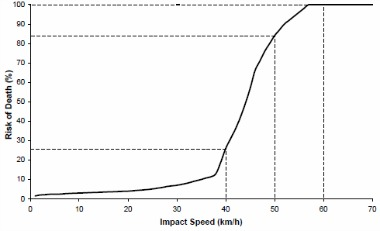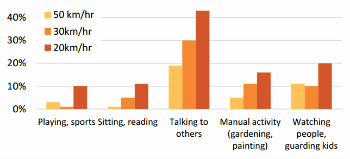Safe speed
"The road system must allow for human error [including pedestrian error] and provide forgiving environments that prevent serious injury or death when crashes occur. Speeds must be managed so that humans are not exposed to impact forces beyond their physical tolerance." (National Road Safety Strategy 2010-2020, p.34).
Evidence
 Probability of fatal injury in relation to vehicle speed ('Improving Pedestrian Safety,' Curtin-Monash Accident Research Centre)
Probability of fatal injury in relation to vehicle speed ('Improving Pedestrian Safety,' Curtin-Monash Accident Research Centre)
The relationship between speed and road traffic accidents is well established. Speed is one of the major factors contributing to accidents on Victoria's roads.
Pedestrians are at greatest risk of excessive or inappropriate vehicle speed. This is discussed in the Curtin-Monash Accident Research Centre's fact sheet Improving Pedestrian Safety and in more detail in The Impact of Lowered Speed Limits in Urban/Metropolitan Areas. The risk of pedestrian death rises exponentially with collision speeds beyond 30 km/h. It is estimated that less than 10% of pedestrians would die when struck by a vehicle travelling at 30 km/h, compared with fatality rates of 26% at 40 km/h and over 80% at 50 km/h.
A comprehensive study of 20 mph (32km/h) zones in London, reported in the British Medical Journal, found a 32% reduction in pedestrian casualties (fatalities and injuries). The benefits for child pedestrians were extraordinary - a 47% reduction for those aged 0-5 and a 51% reduction for 6-11 year olds. And it certainly wasn't only pedestrians who benefited - there was a decrease of 42% for traffic casualties overall.
A reduction in speed limits on local roads is predicted to have only a minor impact on average travel time (Social Cities p.38). Longer driving trips will largely take place on arterial roads.
Victoria Walks is a member of the SafeSpeed Interest Group. In 2008 the Group commissioned an evidence review on promoting safe walking and cycling by reducing traffic speed.
The Austroads report Driver Attitudes to Speed Enforcement looks at that particular issue in detail. It found that the presence of pedestrians was already an important influence on the speed of drivers.
For further information on pedestrians and traffic speed, see our submission to the VicRoads Speed Limit Review 2011. The Glassboy video is also an excellent visual interpretation of how reducing speeds can save lives.
Victoria Walks Position Statement - Safer Urban Speed Limits
After reviewing the evidence and consulting with road safety experts Victoria Walks has issued a comprehensive position statement on speed limits.
Key recommendations for the state government include:
- Review speed limits on arterial roads currently set at 60 km/h or more
- Reducing the default urban speed limit for local roads from 50 to 40 km/h
- Give councils the option of applying 30 km/h speed limits in areas of high pedestrian activity
- Rethink school zones to allow reduced speed across the school neighbourhood, not limited to outside the school gate
- Simplify state government approval processes for reduced speed limits and invest in street changes to support lower speeds.
While reduced speed limits might attract some noisy opposition, a recent survey found 64% of Australians and 66% of Victorians support lower speed limits in neighbourhood streets.
Read our news story on release of the position statement or check out the full position statement with evidence in support of lower speeds.
Local examples
In Victoria, implementation of safe speed has been led by Yarra City Council, who have incrementally introduced 40kmph speed limits to the point where this is the default speed in local roads. The City of Port Phillip has also introduced Speed Limited Local Areas (40km/h speed limits) to the majority of their local streets - illustrated in this map.
Maribyrnong City Council has been progressively implementing its Safer Roads program area by area since 2018. This has involved reducing speeds on local roads from 50km/h to 40km/h and working with the Department of Transport to reduce speeds on some arterial roads from 60 to 50 km/h. This program was completed in November 2021 and 93% of all local streets are now 40 km/h - more here.
A number of strip shopping areas also have 40km/h limits, including 18 that were added by the review of speed limits in 2012.
International uptake
Safe speed is gaining increased recognition around the world. Low neighbourhood speed limits (usually 20 miles per hour or 32 km/h) are a common feature of active transport promotion internationally and are considered to have contributed to safer walking conditions.
In the UK, the recent guidelines for local speed limits promote 20 miles per hour limits. See our news item for more. There is a substantial movement to reduce speed limits in the UK led by 20s Plenty for Us.
In Canada, the Chief Coroner of Ontario recommended reduced speed limits as part of a 'complete streets' approach to road management, after a detailed investigation of pedestrian deaths.
Speed and social connections
 Percentage of people taking part in activites on street in relation to speed ('Social Cities' Grattan Institute).
Percentage of people taking part in activites on street in relation to speed ('Social Cities' Grattan Institute).
The social implications of traffic and speed have been found to have an adverse effect on social connections. A study in Basel, Switzerland, indicates that speed can be a significant factor in preventing social connections at a street level (Social Cities p37). People who live on streets with faster traffic are around half as likely to take part in street based activities that are fundamental to good neighbourhood environments.
"There are many urban locations with a high level of pedestrian activity - for example, around entertainment and shopping districts, schools, universities, hospitals and public transport interchanges. In these situations reducing traffic speeds may be the most appropriate course of action."
(Federal Ministerial Statement on Walking, Riding and Access to Public Transport).